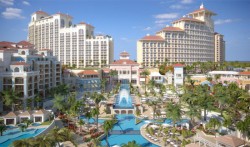Cat Island, Bahamas – With the eye of Hurricane Frances passing directly or close to it and several other islands, including Eleuthera, next to Grand Bahama and Abaco, San Salvador sustained the third worse damage.
After touring Cat Island last week to assess the damage caused by Hurricanes Frances and Jeanne, a restoration team from the National Emergency Management Agency (NEMA) and officials from the Ministry of Housing announced that restoration efforts in San Salvador are continuing with some 21 houses being rebuilt.
Building Control Officer Pat Evans told the Guardian that the San Salvador suffered far worse damage than Cat Island.
“When we did the assessments in Sal Salvador, it was far worse that this (Cat Island). So this is Easy Street. We did the organization for restoration from when we were in Nassau. I did San Salvador before I came here. So we had a model that we were following, and it was just a matter of implementing it and setting it up,” he said.
Co-ordinator for restoration efforts in San Salvador and Cat Island, Kirkland Lopez said that with the exception of Grand Bahama and Abaco, San Salvador was the worst hit island by Hurricanes Frances and Jeanne.
“Just about every house in San Sal has had hurricane damage just like East Grand Bahama and the Abacos,” he said.
AES donated
He said it was difficult to estimate how much it cost the Government to repair the homes in San Salvador because all the materials used were donated by the AES Corporation in New York.
“They had initially been assigned to go into Grand Bahama, that was the initial intent but because of the extent of damage in San Salvador and the unavailability of materials locally, the Government agreed that they should shift their donations to San Sal. So they took materials and labour to San Sal to effect what we have up there as restoration activity,” he said.
Unfortunately, Mr. Lopez said, persons whose homes were severely damaged had to remain in their homes during renovations, and others whose homes were not damaged too badly, moved in with relatives.
“The repairs are still ongoing. We’ve finished Phase I totally. Phase I looks at protecting the house from the external environment – so that’s the roofs and the shutters. All the roofs have been repaired and all the shutters have been repaired. Our next step now is to go inside and do all the ceiling, electrical work, plumbing and little works on the inside,” he said.
Steady progress
And of the remaining houses to be rebuilt, he said, “We have excavated the foundations for almost all of the 21. We have blocked up quite a number of foundations. Some are up to the roofs, and most of the sidings are up on about 15 of those and we have five that we should be putting the roof on by the end of this week,” Mr. Lopez said.
While the Government will not provide furnishing for the houses, residents will have access to the Government Guaranteed Loans Programme, he said.
According to Mr Lopez, with respect to the Central and South East Bahamas, “Those whose houses had to be rebuilt, we hope would have a new home for Christmas.”
Vanessa Rolle, The Nassau Guardian



